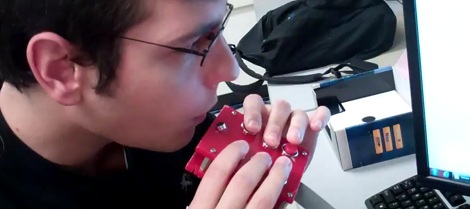
[Joe] and [Evan] wanted to have some fun with their FPGA course at Cornell. When faced with what to do at the beginning of the semester, they figured additive synthesis was a worthy pursuit. They ended up building the Ocarina of Time for their final project.
The guys started by recording a real ocarina and figuring out the relative power levels of each harmonic. Because any sound can be synthesized from a bunch of sine waves, having their Altera FPGA board replicate those frequencies produces a nice ocarina sound
[Joe] and [Evan]’s ocarina has a ‘mouthpiece’ that is just a small microphone. This mic is hooked up to the FPGA board and controls the volume. Sadly, the guys didn’t have time to take apart an N64 controller so 6 red buttons serve as the finger holes.
From the video after the break, [Joe] and [Evan] really pulled together something that sounds like Link’s Ocarina. Great work, guys.
[youtube=http://www.youtube.com/watch?v=dBLMK4ax-HM&w=470]
















The title made me think someone had put the entire game + N64 on an FPGA. The actual project, while neat, isn’t nearly as impressive.
That was my first thought, as well.
Same :S
My impression was a sonic time machine pressed into a fpga.
These guys are going to go places as engineers..no really
could clean up the crackling a little bit. Otherwise not bad. I think i’ve seen this as an iphone app.
Reminds me design-wise of the side-by-side EWI Brecker was playing in the last few years of his life.
http://www.youtube.com/watch?v=u3nlWilBsWw
Fingering pattern on that doesn’t look right… but I’m a flute/clarinet/sax guy — and the ocarina was always an odd duck…
From the sound all I’m hearing is some form of ramp or sawtooth with little harmonic… so the term additive really doesn’t seem to apply. Very 80’s synth sounding to my ears… How many operators is it? Ah, reading through it’s basically two operator; and they aren’t full channel… I know, I know, I’m spoiled by Sample Modeling’s softsynths…
Never would have thought of using a cheap directional mic as the sensor — here I am screwing around with trying to get a MPXM2010GS transducer to talk to a teensy++ for my own homebrew EWI… seems a simpler solution, though probably not the most accurate.
All in all a cute little project though.
Looks like it’s modeled after a 6-hole pendant ocarina. The fingering pattern on those isn’t very intuitive to start with, and they placed the 2 bottom holes on the top, next to the other 4, which makes it all the more confusing.
OTOH, they did a good job actually modeling the sound using sine waves and making it playable.
IMO pressure transducers are the way to go for this kind of wind controller. There’s a reason why all commercial ones (e.g. Akai and Yamaha) use them – they work.